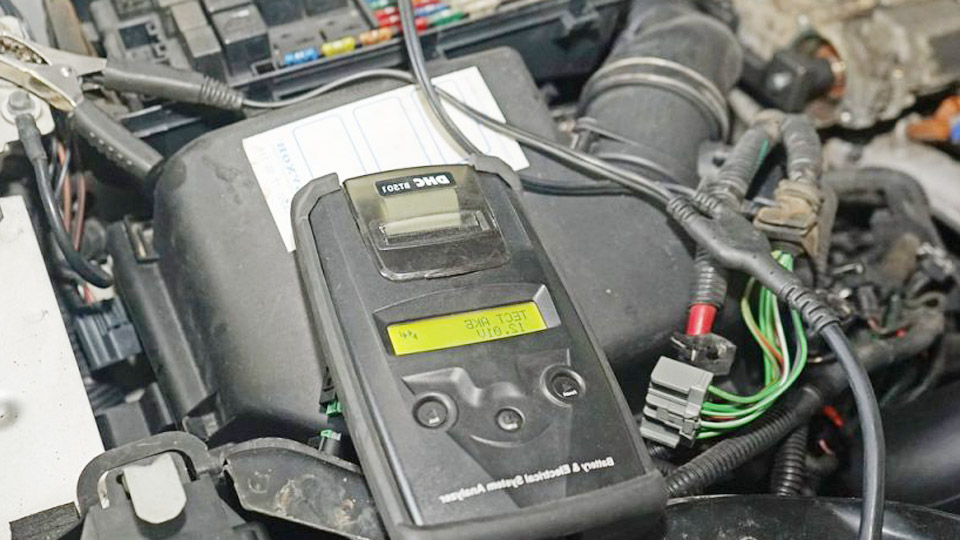How to Check Alternator If Car Won’t Start?
I’ve been there—turning the key in my car, only to hear a weak click or nothing at all. It’s frustrating, especially when I’m late for work or stuck in a parking lot. One of the first things I think about is the alternator. It’s a key part of keeping my car’s battery charged and the electrical system running. If you’re wondering how to check the alternator when your car won’t start, I’m here to help.
I’ve spent years tinkering with cars, from my old pickup to my daily driver, and I’ve learned how to diagnose alternator issues the hard way. Let’s sit down together, like we’re in my garage, and I’ll walk you through every step. This guide is for anyone, whether you’re new to cars or a seasoned DIYer. We’ll figure out if your alternator is the culprit and get you back on the road.

Photo by bestride
Why the Alternator Matters
The alternator is like the power plant of your car. It generates electricity to charge the battery and run things like lights, radio, and wipers. When I turn the key, the battery starts the engine, but the alternator takes over to keep everything powered. If the alternator fails, the battery drains, and the car might not start.
I’ve seen this happen with my old sedan. It cranked slowly, then stopped altogether. I thought it was just the battery, but the alternator wasn’t charging it. Checking the alternator first can save time and money. It’s a common issue, and knowing how to test it gives me confidence to fix the problem or know when to call a mechanic.
Signs of a Bad Alternator
Before I grab my tools, I look for clues that the alternator might be the issue. Not every no-start problem is the alternator, but these signs point me in that direction.
The dashboard warning lights are my first hint. If the battery light or “ALT” light is on, it’s a red flag. I’ve also noticed dim headlights or flickering interior lights when the alternator struggles. A weak or slow crank when I turn the key is another clue. Sometimes, I hear a whining noise from the engine bay—that’s often the alternator’s bearings going bad.
Other times, my car starts but dies quickly. That’s a sign the alternator isn’t keeping the battery charged. If I see these symptoms, I know it’s time to check the alternator. But I also consider the battery, since a dead one can mimic alternator issues.
Tools You’ll Need
I love being prepared before diving into a car repair. Checking the alternator doesn’t need fancy gear, but having the right tools makes it easier. Here’s what I keep in my toolbox for this job.
- Multimeter: This measures voltage to test the alternator and battery. I got mine for $20 at an auto parts store.
- Screwdrivers and Wrenches: To access the alternator or battery terminals.
- Battery Charger: To charge the battery if it’s low.
- Gloves and Safety Glasses: To stay safe around the engine.
- Wire Brush: To clean battery terminals.
- Owner’s Manual: To find the alternator and wiring details.
I already had most of these, but you can find them cheap at hardware stores. With these tools, I’m ready to diagnose the problem.
Step-by-Step Guide to Checking the Alternator
When my car won’t start, I follow a clear process to check the alternator. It’s like being a detective, ruling out other issues first. Here’s how I do it, step by step.
Check the Battery First
I always start with the battery because a dead one can make it seem like the alternator’s bad. I use my multimeter to check the battery voltage. With the car off, a healthy battery reads 12.4 to 12.6 volts. If it’s below 12 volts, I charge it and try starting again.
I also inspect the battery terminals. Corrosion or loose connections can stop the car from starting. I clean them with a wire brush and tighten them with a wrench. Once, my car wouldn’t start because of a loose cable—fixed it in five minutes!
If the battery’s good but the car still won’t start, I move to the alternator.
Inspect the Alternator Connections
Next, I check the alternator itself. It’s usually near the front of the engine, with a belt driving it. I look for loose or damaged wires. A loose connection can stop the alternator from working. I tighten any bolts and check the wiring harness for fraying.
I also look at the alternator belt. If it’s loose, cracked, or missing, the alternator can’t spin properly. I press the belt with my thumb—it should deflect about half an inch. If it’s too loose, I tighten it using the tensioner bolt. One time, a slipping belt was my only issue.
Test the Alternator Voltage
This is where my multimeter shines. I start the car (if it’ll start) and set the multimeter to DC volts. I touch the red probe to the alternator’s positive terminal (usually marked “B+”) and the black probe to a metal ground, like the engine block.
A working alternator should show 13.5 to 14.5 volts with the engine running. If it’s below 13 volts, the alternator isn’t charging properly. If the car won’t start, I jump-start it to run this test. My friend’s car once showed 12 volts—his alternator was toast.
Load Test the Alternator
To be thorough, I test the alternator under load. With the engine running, I turn on the headlights, radio, and AC. Then, I check the voltage again. It should stay between 13.5 and 14.5 volts. If it drops below 13, the alternator can’t handle the load.
I did this on my truck and saw the voltage dip to 12.8 volts with everything on. That told me the alternator was struggling. A shop confirmed it needed replacing.
Listen for Noises
Sometimes, I hear a whining or grinding noise from the alternator. That’s usually the bearings failing. I use a mechanic’s stethoscope (or a long screwdriver) to listen closely. If I hear grinding, the alternator might still work but won’t last long.
Check the Charging System
If the alternator tests okay but the car still won’t start, I look at the whole charging system. The voltage regulator (often inside the alternator) controls the output. A bad regulator can cause low voltage. I also check the fuses for the charging system—my manual shows where they are.
Here’s a table summarizing the tests I do:
| Test | What to Check | What It Means |
|---|---|---|
| Battery Voltage | 12.4-12.6 volts (engine off) | Low voltage means a dead battery |
| Alternator Connections | Loose wires or belt | Fixes simple issues like loose cables |
| Alternator Voltage | 13.5-14.5 volts (engine running) | Below 13 volts means alternator failure |
| Load Test | Voltage stays 13.5-14.5 under load | Drop below 13 volts means weak alternator |
| Noise Check | Whining or grinding from alternator | Bad bearings may need replacement |
Common Alternator Problems
I’ve seen a few things go wrong with alternators. Knowing these helps me pinpoint the issue.
Worn Brushes
The brushes inside the alternator wear out over time. This stops it from charging the battery. I had this on my old car—replacing the brushes was cheaper than a new alternator.
Bad Bearings
Bearings let the alternator spin smoothly. If they fail, I hear whining or grinding. My friend ignored this, and his alternator seized up, snapping the belt.
Faulty Voltage Regulator
The regulator keeps the voltage steady. If it fails, the alternator might overcharge or undercharge. I saw crazy voltage swings (16 volts!) when my regulator went bad.
Broken Diodes
Diodes convert the alternator’s AC power to DC. If they fail, the battery doesn’t charge properly. This needs a professional test, but it’s rare.
Loose or Broken Belt
A loose belt slips, reducing output. A broken belt means no power at all. I check the belt every oil change to catch issues early.
What to Do If the Alternator Is Bad
If my tests show the alternator’s faulty, I have a few options. Here’s how I handle it.
Replace the Alternator
Most alternators aren’t worth repairing unless it’s just brushes. I replaced mine for $150-$300, depending on the car. It’s a few hours’ work—remove the belt, disconnect wires, and unbolt the alternator. I save money doing it myself, but a shop charges $300-$600 with labor.
Rebuild the Alternator
Some shops rebuild alternators, replacing brushes, bearings, or diodes. It’s cheaper, around $100-$200, but not all alternators are rebuildable. I tried this once, but the rebuild failed after a year, so I prefer new ones.
Get Professional Help
If I’m not sure or don’t have time, I take it to a mechanic. They test the charging system and replace the alternator if needed. I pay for peace of mind, especially if wiring’s involved.
Preventing Alternator Problems
I’ve learned that a little care keeps my alternator happy. Here’s what I do to prevent issues.
Regular Maintenance
I check the battery and alternator connections during oil changes. Clean terminals and tight bolts make a difference. I also inspect the belt for cracks.
Avoid Overloading
Running too many accessories—like big stereos or extra lights—strains the alternator. I only add what my car’s system can handle.
Monitor Battery Health
A bad battery makes the alternator work harder. I test my battery yearly and replace it every 4-5 years. It saves the alternator from burnout.
Listen for Warning Signs
Whining noises or dim lights get my attention. Catching problems early prevents a dead car. I fixed a loose belt once before it caused bigger issues.
When It’s Not the Alternator
Sometimes, the alternator tests fine, but the car still won’t start. I’ve run into this and had to dig deeper. Here are other culprits I check.
Dead Battery
A battery too weak to hold a charge won’t start the car, even with a good alternator. I replace it if it’s old or fails a load test.
Starter Motor
A bad starter can mimic alternator issues. If I hear a click but no crank, I test the starter with my multimeter. It’s a $100-$200 fix.
Wiring or Fuses
Faulty wiring or a blown fuse can cut power. I check the main fuses and wiring harness for damage. A $5 fuse once saved me a tow.
Ignition Switch
If the key won’t turn or nothing happens, the ignition switch might be bad. I had this on an old car—a $150 repair at the shop.
When to Call a Professional
I love DIY, but some jobs are best left to pros. Here’s when I take my car to a shop.
Complex Electrical Issues
If the alternator tests okay but the car still won’t start, wiring or computer issues might be the problem. A mechanic has tools to diagnose this.
No Tools or Time
Testing requires a multimeter and some know-how. If you don’t have them, a shop can test the alternator for $50-$100.
Safety Concerns
Working near a running engine or electrical system can be risky. If I’m unsure, I let a pro handle it. It’s worth the cost for safety.
Costs of Checking and Fixing
Checking the alternator is cheap if I do it myself. A multimeter costs $20, and my time is free. Here’s what I’ve spent on fixes:
- Battery: $100-$200
- Alternator: $150-$300 (DIY) or $300-$600 (shop)
- Rebuild: $100-$200
- Professional diagnosis: $50-$100
Doing it myself saves hundreds, but I only tackle what I’m comfortable with.
Why I Love Knowing My Alternator
Understanding how to check my alternator gives me confidence. I’m not stranded wondering what’s wrong—I can test it and decide what to do. It’s empowering to pop the hood, grab my multimeter, and figure it out. Even if I need a mechanic, I know what to ask for, which saves time and money.
Conclusion: Get Your Car Running Again
Figuring out how to check the alternator when my car wouldn’t start was a game-changer. It’s not just about fixing a problem—it’s about taking control of my car’s health. From testing the battery to checking the alternator’s voltage, each step brings me closer to a solution. I love the feeling of turning the key and hearing the engine roar back to life after a successful diagnosis.
Whether you’re stuck in a parking lot or just curious, I hope my guide helps you tackle this with confidence. Grab your tools, follow these steps, and you’ll know if the alternator’s the issue. If it’s too much, a mechanic’s got your back. Now, go get that car started and hit the road—your next adventure’s waiting!
FAQs
How do I know if it’s the alternator or the battery?
Test the battery with a multimeter. It should read 12.4-12.6 volts when off. If it’s good, check the alternator’s voltage (13.5-14.5 volts with the engine running). Low alternator voltage points to a bad alternator.
Can I drive with a bad alternator?
Not for long. A failing alternator won’t charge the battery, so the car will die once the battery’s drained. I’d get it fixed ASAP to avoid being stranded.
How much does it cost to replace an alternator?
A new alternator costs $150-$300. DIY takes a few hours. A shop charges $300-$600 with labor. I saved money doing it myself once.
How often should I check my alternator?
I check it yearly or if I notice dim lights, slow cranking, or whining noises. Regular battery and belt checks help catch issues early.
Can a bad alternator damage my battery?
Yes. A failing alternator can overcharge or undercharge the battery, shortening its life. I replace a bad alternator quickly to protect the battery.

David Peterson, the chief editor of sparepartscare. I am an automobile engineer and assign to an local firm with much experience in automobile equipment. During the time, most of my experience is related to the Industry of cars parts. I learned about the thing, when working with experienced inspectors, one must be as good as the inspector, or better, with knowledge of the project as well as the practical aspects of automobile industry.





